In the midst of trendy Western bars and pricey eateries in Hong Kong’s SOHO entertainment district sits a storefront with a Chinese sign, flanked by a mini-shrine to the gods of the earth and prosperity. Red-lettered paper lanterns hang in front of the doorway, remnants of an almost-forgotten past.
Little is given away by the frosted windows and the sign, proclaiming it the “Central 30 Houses Kaifong Yulan Association.” The characters on the sign and the lanterns are two of the few remaining physical records of the area’s old name, a reference to SOHO’s former identity that few recall: a working class Chinese neighbourhood home to labourers, a bustling open-air wet market, and people living in tong lau above family-run businesses.
Though for years the 30 Houses (卅間) community provided crucial goods and services that supported the operations of the city’s finance centre in Central, the stories of its inhabitants are at risk of being forgotten, fading into the past after trendy bars and eateries moved in in the 90s.

Though the neighbourhood’s tong lau buildings have escaped demolition for now, its future is uncertain and residents fear that, if they are excluded from the planning process, their stories and the area’s unique history will be erased.
“Today you probably need to ask elderly people for them to recognise [the name], but we think it’s important to find out the history, or our city’s past will be lost,” said Katty Law, a long-time resident. Law is working with fellow historian Charlton Cheung, whose father lived in the neighbourhood, to unearth the history of 30 Houses.
The historian-activists, who are members of the Central and Western Concern Group, are working to get residents involved in the area’s planning process. By bringing back the name 30 Houses and educating locals about area’s history, they hope to create a collective sense of community that will inspire residents to become involved in shaping the neighbourhood’s future – one that is closely connected to its history.

Today 30 Houses is a disappearing community, both physically and in the minds of Hongkongers. Very few of the original residents are left. After the mid-levels escalators were built, property prices rose and some landlords sold their property, while tenants were forced by soaring rents to move to less expensive areas.
Others left after the Urban Renewal Authority bought out tenement buildings in the 2000s, either moving to public housing or taking compensation from the authority. Many of the buildings have fallen into disrepair and remain vacant, awaiting their fate to be decided. Most visitors and Hongkongers think of the area as SOHO, and business owners and staff at nearby establishments who spoke to HKFP only recognised 30 Houses as part of the Association’s name.

Across Hong Kong, redevelopment projects have been criticised for bulldozing whole neighbourhoods and revamping them into commercial districts without regard for the communities or their cultural history.
For example, Wan Chai’s Lee Tung Street, formerly known for its print shops and businesses focusing on bridal products, was levelled in 2007 despite widespread opposition. The URA worked with developers to turn the site into a shopping centre, now home to high-end shops and gourmet cafes housed in European-style buildings.
“Due to redevelopment a lot of places are being erased,” Law said. “It is so important that we keep our communities and neighbourhoods alive by studying the history and passing this on to our future generations. We don’t want to become a city without history.”
Rich history and redevelopment
30 Houses roughly encompasses the area now known as SOHO – between Hollywood Road and Caine Road and from the escalators at Shelley Street to the end of Bridges Street.
A key group of tenement buildings on Staunton Street and nearby alleys have been targeted in the Urban Renewal Authority’s H19 project for over a decade, but the plan was delayed by public resistance and the statutory body’s inability to buy the majority of properties from residents.

In 2010, the URA decided to revise its plan and preserve a dozen tong lau on Wing Lee Street after award-winning film Echoes of the Rainbow was shot there, spurring calls to save the buildings. Another proposal to demolish about a dozen buildings to make way for high rise residential towers was withdrawn last year following public outcry, and the URA said in June that it would shelve the H19 project.
But its future is still unclear – the URA said it was still making a decision and hopes to make an announcement this year. URA chief Wai Chi-sing said it would look into options to fix up the properties it bought and perhaps use them for shared housing or allow their use by NGOs.
The neighbourhood’s rich history is embodied in the name 30 Houses. Based on newspaper reports, official records, maps, and interviews with residents, Law and Cheung believe that it came from 32 stone houses that were built in a row, one next to another, along Bridges Street in the mid 19th century.

The original settlement was largely destroyed by bombing during the second world war. As the colonial government lacked the resources to acquire the land, the redevelopment was undertaken by private developers and driven by a group of prominent Chinese citizens.
“After the war, a lot of buildings had collapsed… but there was also a large influx of refugees who were living in temporary shelters,” Law said. “The government’s concern at the time was how to clear the slum and how to redevelop the area – how to rebuild it.”
The government built a school, the Bridges Street Market, and a public latrine with bathing facilities to provide for residents’ basic needs. Though Cheung found fewer mentions of the name in archives starting from the ’50s, after the original buildings were gone, the name persisted in common usage by the kaifong. (Kaifong in local usage is used for a neighbourhood or for its inhabitants).
As time went by, the 30 Houses name also started being used to refer to surrounding areas – including Staunton Street, Wing Lee Street, Shing Wong Street, Wa In Fong and Chung Wo Lane. As the researchers found, everyone had a slightly different idea of where the boundaries were.
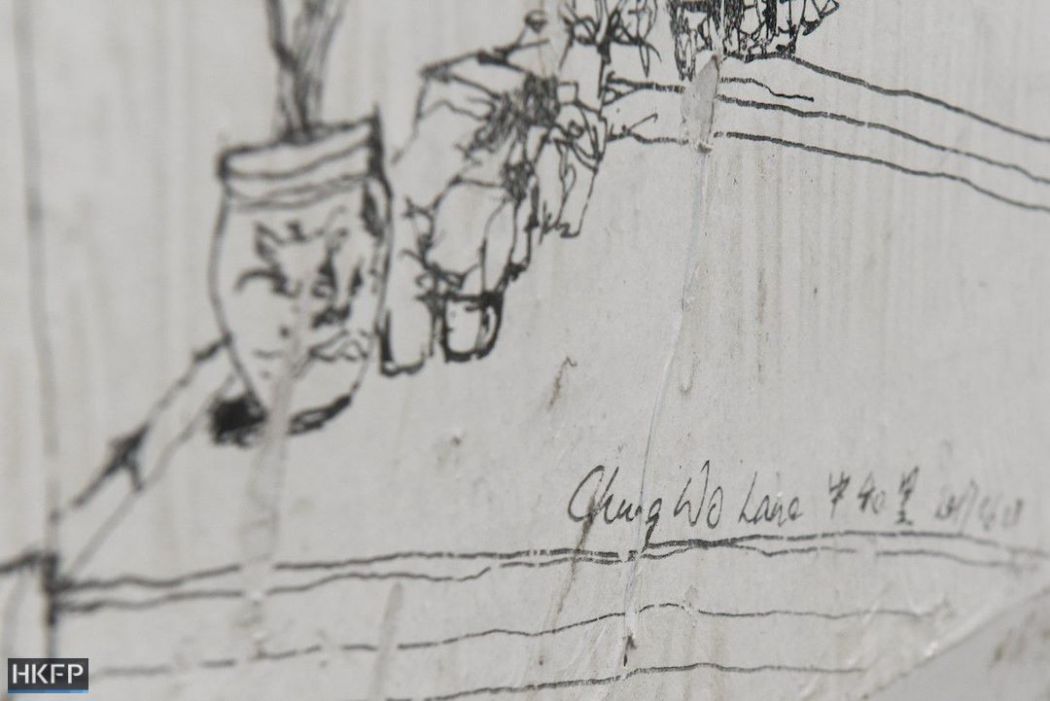
Up until the 60s and 70s, the area contained many coolie houses, which housed labourers who came from southern China. These bunkhouses paid the coolies for their work, and labourers often shared beds, sleeping while their bed mates worked a different shift, according to Law.
Cheung sees the area as a vital pillar that supported the banks and big companies in Central – since before the war, when coolies would move goods to and from the harbour for the foreign firms, all the way to the printing shops that thrived in the area during 50s to the 90s.
“Those big foreign firms in Central still needed people to move goods, so you need coolies. And you need food. People would prepare food here and carry it over there [using bamboo poles on their shoulders],” he said.
Today, SOHO plays a very different role, though it still provides goods and services to people in Central.
“SOHO and Central are linked on the same social level now – most of the people who work in Central are high-class folks. So after they get off work they go to SOHO to have a good time,” Cheung said.

The name was commonly used by residents and appeared in Chinese-language newspapers, but Law and Cheung weren’t able to find the 30 Houses name in English, even though they looked through many official documents.
“All along we’ve been unable to find [the English version of] 30 Houses in official documents, until finally we thought to look at the Yulan Association’s commercial registration,” Cheung said.
The colonial government probably chose to refer directly to the street names rather than the Chinese name used by common people, which officials would not have recognised, the researchers said.
Though the area may not have had an official identity, its residents thought of themselves as 30 Houses kaifong.
Fifth floor, number ten
Sam Yam’s family moved to 30 Houses in 1967 and owned a letterpress print shop on Wa In Fong. On the same block around Shing Wong Street, ten out of 12 stores were print shops, he recalled. At a young age, he would help his father in the shop, running errands such as buying letter blocks from suppliers on Gage Street and learning the trade. He eventually married one of his neighbours – a young woman whose brother also ran a printshop in 30 Houses.
“She lived on the fifth floor of number ten Wing Lee Street, and I lived on the fifth floor of number ten Shing Wong Street,” he said.

Business was good – the print shop hired employees who worked until 6pm and Yam’s family would continue after they left, until all the work was done. He recounted how, before one of their early dates, he fell asleep after a long day at work, and his then-girlfriend waited nearly an hour for him to show up.
“There were no working hours, because it was your own business,” he said. “She was a little mad, but not a whole lot, because we had just met.”
When his landlord sold the property in 1983, Yam moved the shop to nearby Sheung Wan, where he still operates a Heidelberg machine, though mostly for educational workshops nowadays. “It was truly the golden years at that time,” he said.
After rent rose in the ’90s, print shops started to decrease, and the peripheral businesses supplying accessories, ink, and paper goods also began to move away, Yam said. Many shops then moved to other areas – such as industrial buildings – to be closer to the suppliers.

Now, the letterpresses are gone, and the rice sellers and noodle stalls have been replaced by convenience stores, high-end bars, and high-rises.
Yam’s last connection to the neighbourhood was severed when his sister moved away in the last decade, but he said he likes to return occasionally to “reminisce about the past.” However, he said he does not patronise the coffee shops and restaurants as they were too highbrow for his taste.
“If there was stuff that was more for common people there then maybe.”
Yu Lan Association
Today, the clatter of mahjong tiles can still be heard behind the frosted windows of the Yulan Association, which organises the annual Yu Lan – also known as the Hungry Ghost – Festival for the 30 Houses kaifong. The association is still an important gathering place for elderly kaifong, but it is at its most popular during the annual celebration, when many of the former residents come back to pay their respects to ancestors and catch up with old friends.
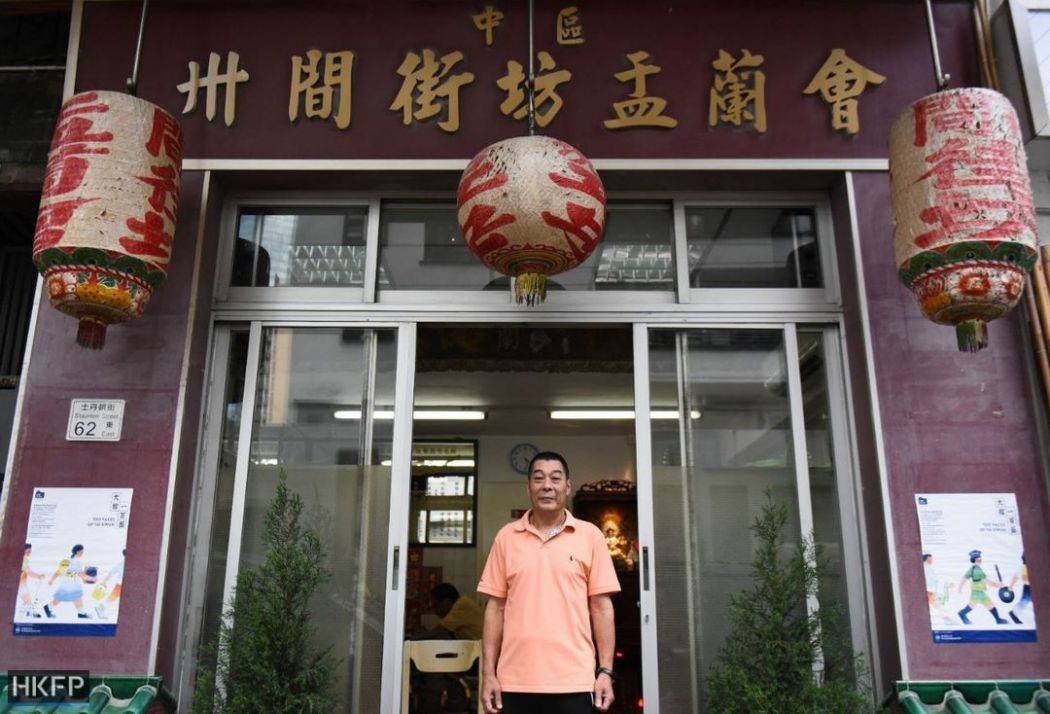
The Yu Lan festivities have been run for 26 years by 69-year-old Wong Kun-oi. He said that the tradition dates back many years, back to the pre-war days. The festival was an important occasion for the workers from Southern China, and the coolie houses would compete with each other to host the most elaborate festivities.
The Association depends on the work of volunteers and on donations from kaifong and local businesses to keep running, but Wong says it’s getting harder to raise money in recent years.
The association is losing both resources and manpower, said Wong – according to him only 10 per cent of the area’s original businesses and inhabitants are left, and the new bars and eateries rarely donate to the festival. “They’re happy when it’s Halloween,” he said.
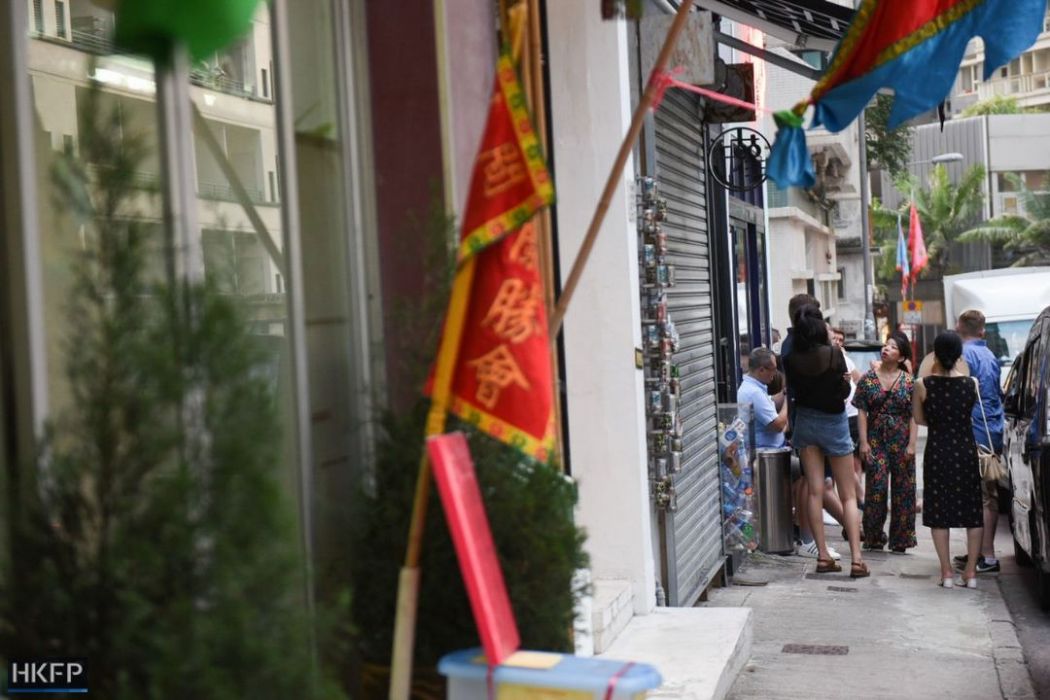
“Before when we would go ask for donations, we would get about HK$10,000 after doing one round – now it’s about HK$3,000.”
“Now we rely on the association’s leaders and members to go around with the red book and ask their friends and family… and on the association leaders to be more warm-hearted, and more generous to make up the difference when it’s not enough. But now they’re getting older and older, and it all comes out of their savings.“
”It’s not like before when there was business, because they could always make it back… now it comes out of their retirement fund and it’s a bit more painful to give it away.”
As this year’s festival approaches on September 3, Wong only hopes the association will be able to continue operating and stay at its current building on Staunton Street, which is owned by the URA. “We are just taking the steps as they come.”
Revitalisation
On a Sunday afternoon in August, the activists from the Central and Western Concern Group gathered around an unused lot next to number 2A, Shing Wong Street. The tong lau was torn down in the 90s, after the building became too damaged to live in, and locals criticise the government for using it “to breed mosquitoes.”
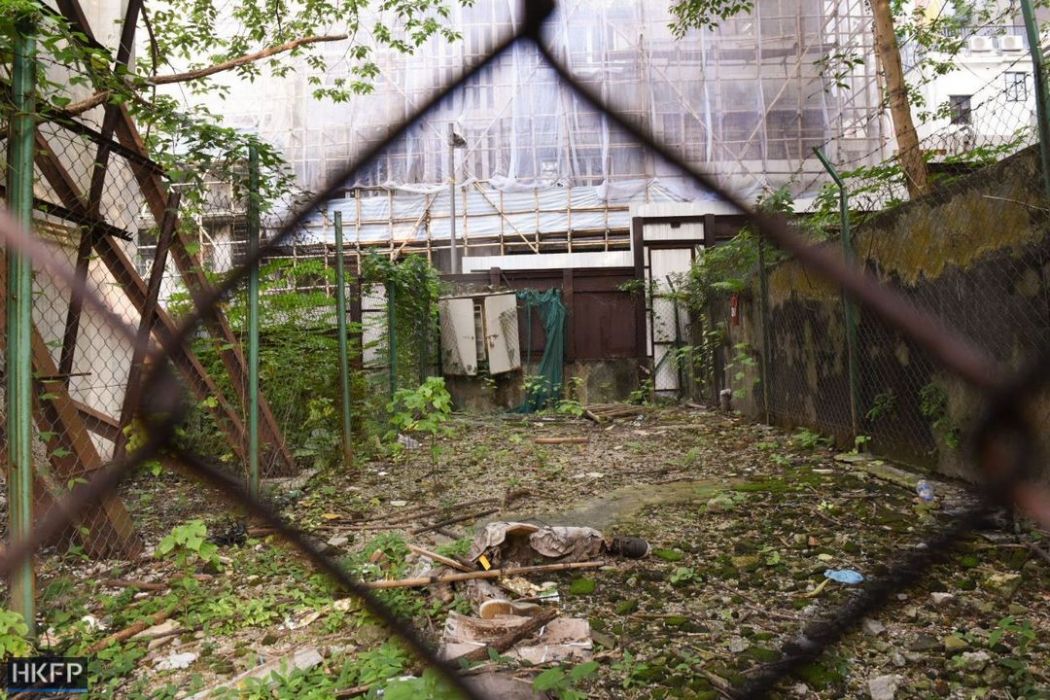
The group was soliciting ideas from residents on how to use the space after it was made available by the government for short-term community use. They are floating the idea of a “community living room,” where residents can hang out, attend screenings and join history talks given by former kaifong.
The project is one of several that the group is working on to revitalise the area and promote its history. Others include walking tours, history talks, and gathering oral history accounts from former residents that can then be shared in a small museum or a zine.
Residents and passersby left their suggestions on colourful post-it notes stuck to a wall. They included a climbing gym and playground for kids, a market, a community garden, outdoor screenings, and a suggestion to “get it opened and share with the public.”

Mark Thomsen, a photographer who has been living in the area for 13 years but moved to a tong lau apartment on Shing Wong Street weeks ago, had not heard of 30 Houses until he passed by the lot and the activists persuaded him to join a walking tour led by Cheung.
He said the promotion of 30 Houses’ name and history would help to foster a sense of community and belonging among residents.
“It’s good to be able to put all the pieces of the puzzle together, things that I’ve seen and walked by for 13 years, to know about the history behind them and when they were built and how they fit the stories behind them,” he said.
“It takes it from black and white and starts to add colour to it.”
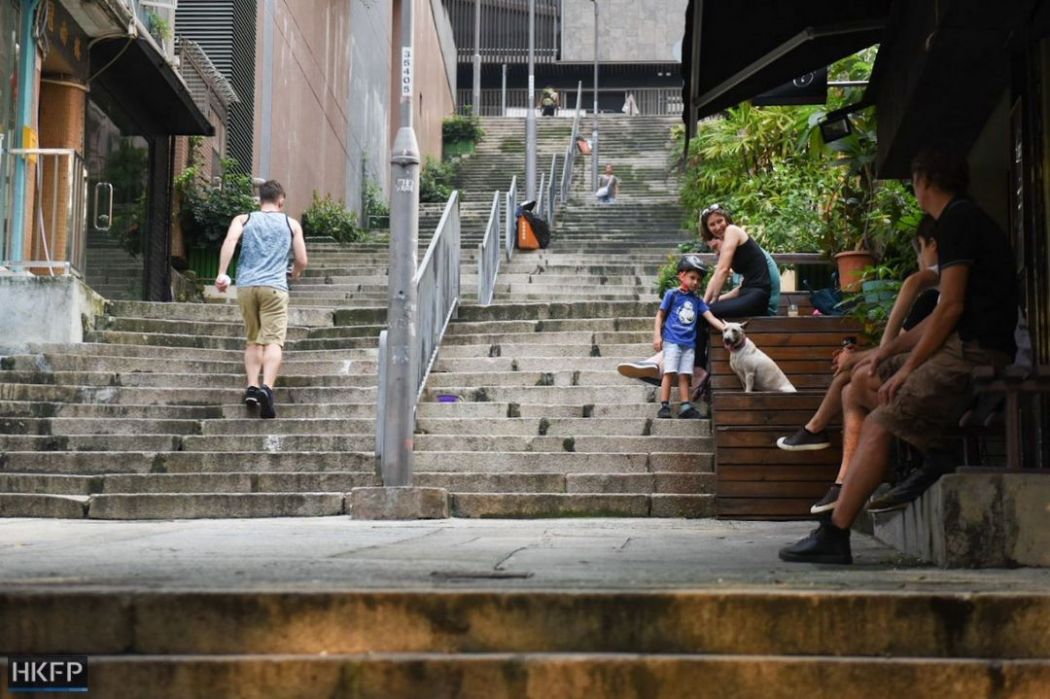
Law also hopes to give use of the space back to former kaifong who may not hang out at the restaurants and coffee shops in the area.
“Our thinking is that this place should be open. It shouldn’t be somewhere you have to spend money to be able to enter.”
The government’s Old Town Central campaign to promote historic attractions lack depth and a coherent story to connect the sites, Law said.
“There isn’t a lot of story to connect everything… but 30 Houses has a lot of potential to provide that story.”
“The old city has many of these people’s stories hidden within it,” Law said. “They may be coolies, vendors in the wet market, or print shop workers, they are Central’s building blocks, they helped us build this place.”
The Central and Western Concern Group is hosting a film screening and tour to introduce the 30 Houses Yulan festival on September 2. The Yulan Association will host its festivities on September 3.
